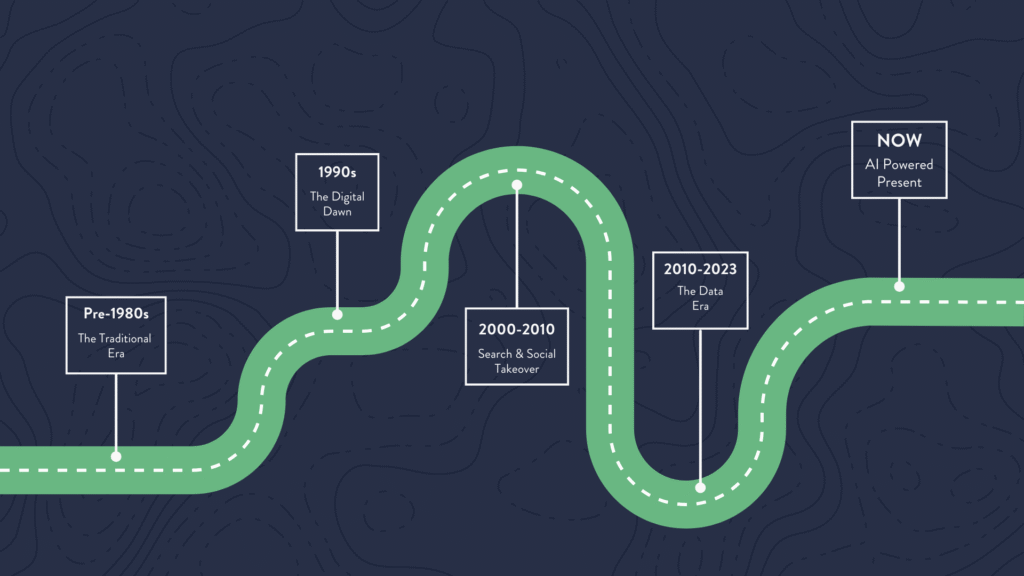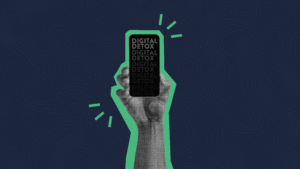The world of marketing has never been static. It’s fast-moving and ever-changing, and thanks to technological advancements over the last 30–40 years, it’s evolving more rapidly than ever. We’re now in the midst of a profound transformation—but this shift didn’t come out of nowhere. The current state of marketing is simply the next step in a long history of natural progression.
When the world changes so quickly, it’s easy to feel overwhelmed—to either stick your head in the sand or push back against the tide. But what if, instead, we looked for the good and embraced change through the lens of opportunity? To do that, we need to look back at the pivotal moments that shaped modern marketing. From the golden age of Madison Avenue to algorithmic targeting and now intelligent automation, each chapter built the foundation for the next.
The Traditional Era: The Age of Mass Marketing (Pre-1980s)
In the traditional era of marketing, the goal was to reach everyone. Print, radio, and especially television reigned supreme as the best way to cast a wide net. These channels allowed brands to deliver big messages to broad audiences.
Marketing was a one-way street. Brands spoke, and consumers listened—with few opportunities to offer feedback. Success wasn’t measured by real-time data but often by gut instinct or post-campaign sales figures. Without feedback loops, marketing had reach but little direction.
You had to make an impact, and you had to make it fast. The best way to do that? Be memorable, tell a compelling story, and be everywhere. If no one could escape your brand, you were more likely to succeed. But that kind of ubiquity came at a price—only brands with the biggest budgets could afford to dominate.
The Digital Dawn: Websites and Email Change the Game (1990s)
Then came the internet. Suddenly, brands could build websites, publish content on demand, and communicate directly with customers via email. This was the birth of the digital channel—and it opened the door for anyone with a bit of know-how to create a digital presence and manage their brand more directly.
In 1994, AT&T launched the first banner ad on HotWired.com (now Wired), introducing online advertising to the world. It proved that brands didn’t need TV or radio slots to reach audiences—they could reach people anytime, anywhere, 24/7.
This ushered in permission-based marketing, interactive advertising, and the early days of data collection. Now, customers could invite their favorite brands into their inboxes instead of relying on chance encounters. Email marketing began to rise, and traditional advertising started to share the stage with digital marketing.
Search & Social Take Over: The 2000s–2010s
In just 10 short years, we took the next leap. Search engine marketing and social media changed everything. Google AdWords (now Google Ads), launched in 2000, allowed marketers to pay for the chance to appear at the top of search results—reaching people actively seeking solutions.
At the same time, platforms like Facebook (2004), YouTube (2005), and Twitter (2006) opened the floodgates of real-time engagement. Brands were no longer just broadcasting—they were interacting through posts, comments, and messages. Virality became a key performance indicator, and brand communities began to form.
Then came the iPhone (2007), turning every consumer into a walking, always-on touchpoint. With the rise of mobile and the constant nature of social platforms, influencer marketing emerged. Brands started competing not just for attention—but for attention spans.
The Data Era: Personalization & Marketing Automation (2010s–Early 2020s)
As digital marketing matured, so did the tools to support it. CRM platforms, marketing automation tools, and real-time analytics became the norm.
Marketers moved beyond demographics to target individuals. Emails greeted you by name. Ads followed you from your shopping cart to your Instagram feed. Entire websites changed based on who you were.
Tools like HubSpot, Salesforce, and Mailchimp brought automation to the forefront. Campaigns could now be triggered by user behavior, not just planned schedules. Innovations like A/B testing, lifecycle marketing, and funnel strategies took center stage. And so began the relentless quest for efficiency at scale.
The AI-Powered Present: 2023 and Beyond
Today, we’re entering a new frontier: intelligence-driven marketing. Generative AI tools (like ChatGPT, DALL·E, and Midjourney), predictive models, and machine learning aren’t just accessible—they’re transformative.
Where automation streamlined tasks, AI enhances thinking. It can generate creative assets, predict behavior, write copy, segment audiences, and personalize experiences at an unimaginable scale.
Of course, this evolution brings new questions—about ethics, creativity, strategy, and what it really means to be productive in a world of machine assistance.
How Agencies Leveraging AI Deliver More Value to Clients
So you might wonder: If AI can do all that, do we still need people behind marketing efforts?
Absolutely. AI isn’t here to replace marketers—it’s here to enhance them. For agencies, that opens up powerful new ways to deliver value.
Speed & Scalability
AI tools help create high-quality content that’s scalable and repeatable. Campaign timelines shrink because instead of starting from a blank page, AI provides a creative spark. It’s not about replacing inspiration—it’s about jumpstarting it.
Deeper Insights & Smarter Targeting
With predictive analytics, agencies can identify patterns humans might miss—turning raw data into actionable strategies. What used to take hours of analysis can now be done in minutes, giving brands a faster path to impactful decisions.
Enhanced Creativity
AI-generated visuals, headlines, or ad concepts act as springboards. The first draft from AI might not be perfect—but it’s a strong starting point. Human marketers still shape the message, refine the tone, and inject brand personality. One of AI’s greatest strengths? Helping us think outside the box and explore creative paths we might not have considered.
The Next Chapter Is Already Being Written
Every major shift in marketing has been driven by a combination of technological innovation and changing consumer behavior. The rise of AI is just the latest—and most powerful—tool marketers have ever had.
Agencies that understand the context, embrace this evolution, and integrate AI with intention and creativity will define the next decade of marketing. We’re ready to lead the charge—and we hope you’ll join us on the journey.
The future isn’t man vs. machine. It’s man with machine.


